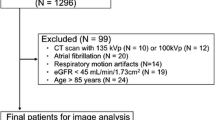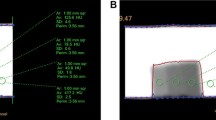Abstract
The aim is to investigate the effect of tube voltage and chest wall thickness on image quality, stenosis measurement, and radiation dose in coronary CT angiography (CCTA) in a phantom study. A phantom with tubes in a box at its center and concentric cylindrical plastic chambers of three layers at its periphery was constructed. The concentric cylinders were filled with oil or left empty to simulate different degrees of obesity. Retrospective CT scanning was performed at different kVps and mAs. Image noise, contrast to noise ratio (CNR), stenosis measurement, and radiation dose were obtained. A CNR higher than 10 was considered to be acceptable for clinical practice. Mean image noise was 51.7 at 80 kVp, 31.6 at 100 kVp, and 24.7 at 120 kVp (P < 0.001). A CNR greater than 10 could be achieved with all the images using 80 kVp as well as using 100 or 120 kVp. However, CNRs at 100 and 120 kVp were significantly higher than the CNR at 80 kVp (P < 0.001). There were no significant differences between 100 and 120 kVp. All stenosis measurements were overestimated. Accuracy of stenosis measurement was significantly correlated with CNR (P < 0.05), but not with kVps. Mean doses were 2.07 mSv at 80 kVp, 3.37 mSv at 100 kVp, and 5.17 mSv at 120 kVp (P < 0.001). CNR per radiation dose was highest at 80 kVp, regardless of chest wall thickness. For CCTA, using 80 kVp with high mAs is the best choice, regardless of chest wall thickness, for minimal radiation dose and sufficient image quality.






Similar content being viewed by others
References
Haberl R, Tittus J, Bohme E et al (2005) Multislice spiral computed tomographic angiography of coronary arteries in patients with suspected coronary artery disease: an effective filter before catheter angiography? Am Heart J 149(6):1112–1119
Janne d’Othee B, Siebert U, Cury R et al (2008) A systematic review on diagnostic accuracy of CT-based detection of significant coronary artery disease. Eur J Radiol 65(3):449–461
Francone M, Napoli A, Carbone I et al (2007) Noninvasive imaging of the coronary arteries using a 64-row multidetector CT scanner: initial clinical experience and radiation dose concerns. Radiol Med 112(1):31–46
Leber AW, Knez A, Becker A et al (2004) Accuracy of multidetector spiral computed tomography in identifying and differentiating the composition of coronary atherosclerotic plaques: a comparative study with intracoronary ultrasound. J Am Coll Cardiol 43(7):1241–1247
Raff GL, Gallagher MJ, O’Neill WW et al (2005) Diagnostic accuracy of noninvasive coronary angiography using 64-slice spiral computed tomography. J Am Coll Cardiol 46(3):552–557
Mollet NR, Cademartiri F, van Mieghem CA et al (2005) High-resolution spiral computed tomography coronary angiography in patients referred for diagnostic conventional coronary angiography. Circulation 112(15):2318–2323
Stolzmann P, Scheffel H, Schertler T et al (2008) Radiation dose estimates in dual-source computed tomography coronary angiography. Eur Radiol 18(3):592–599
Achenbach S, Ropers U, Kuettner A et al (2008) Randomized comparison of 64-slice single- and dual-source computed tomography coronary angiography for the detection of coronary artery disease. JACC Cardiovasc Imaging 1(2):177–186
Leung KC, Martin CJ (1996) Effective doses for coronary angiography. Br J Radiol 69(821):426–431
Coles DR, Smail MA, Negus IS et al (2006) Comparison of radiation doses from multislice computed tomography coronary angiography and conventional diagnostic angiography. J Am Coll Cardiol 47(9):1840–1845
Betsou S, Efstathopoulos EP, Katritsis D et al (1998) Patient radiation doses during cardiac catheterization procedures. Br J Radiol 71(846):634–639
Broadhead DA, Chapple CL, Faulkner K et al (1997) The impact of cardiology on the collective effective dose in the North of England. Br J Radiol 70(833):492–497
Jakobs TF, Becker CR, Ohnesorge B et al (2002) Multislice helical CT of the heart with retrospective ECG gating: reduction of radiation exposure by ECG-controlled tube current modulation. Eur Radiol 12(5):1081–1086
Abada HT, Larchez C, Daoud B et al (2006) MDCT of the coronary arteries: feasibility of low-dose CT with ECG-pulsed tube current modulation to reduce radiation dose. AJR Am J Roentgenol 186(6 Suppl 2):S387–S390
Hausleiter J, Meyer T, Hadamitzky M et al (2006) Radiation dose estimates from cardiac multislice computed tomography in daily practice: impact of different scanning protocols on effective dose estimates. Circulation 113(10):1305–1310
Hsieh J, Londt J, Vass M et al (2006) Step-and-shoot data acquisition and reconstruction for cardiac x-ray computed tomography. Med Phys 33(11):4236–4248
Kalva SP, Sahani DV, Hahn PF et al (2006) Using the K-edge to improve contrast conspicuity and to lower radiation dose with a 16-MDCT: a phantom and human study. J Comput Assist Tomogr 30(3):391–397
Stolzmann P, Leschka S, Scheffel H et al (2008) Dual-source CT in step-and-shoot mode: noninvasive coronary angiography with low radiation dose. Radiology 249(1):71–80
Sigal-Cinqualbre AB, Hennequin R, Abada HT et al (2004) Low-kilovoltage multi-detector row chest CT in adults: feasibility and effect on image quality and iodine dose. Radiology 231(1):169–174
Baek JH, Lee W, Chang KH et al (2009) Optimization of the scan protocol for the reduction of diaphragmatic motion artifacts depicted on CT angiography: a phantom study simulating pediatric patients with free breathing. Korean J Radiol 10(3):260–268
Suzuki S, Furui S, Kaminaga T et al (2004) Measurement of vascular diameter in vitro by automated software for CT angiography: effects of inner diameter, density of contrast medium, and convolution kernel. AJR Am J Roentgenol 182(5):1313–1317
Suzuki S, Furui S, Kaminaga T (2005) Accuracy of automated CT angiography measurement of vascular diameter in phantoms: effect of size of display field of view, density of contrast medium, and wall thickness. AJR Am J Roentgenol 184(6):1940–1944
WHO expert consultation (2004) Appropriate body-mass index for Asian populations and its implications for policy and intervention strategies. Lancet 363(9403):157–163
Jee SH, Sull JW, Park J et al (2006) Body-mass index and mortality in Korean men and women. N Engl J Med 355(8):779–787
Morin RL (1988) Monte Carlo simulation in the radiological sciences. CRC Press, Boca Raton, Fl
Nishino TK, Wu X, Johnson RF Jr (2005) Thickness of molybdenum filter and squared contrast-to-noise ratio per dose for digital mammography. AJR Am J Roentgenol 185(4):960–963
Siegel MJ, Schmidt B, Bradley D et al (2004) Radiation dose and image quality in pediatric CT: effect of technical factors and phantom size and shape. Radiology 233(2):515–522
Park EA, Lee W, Kang JH et al (2009) The image quality and radiation dose of 100-kVp versus 120-kVp ECG-gated 16-slice CT coronary angiography. Korean J Radiol 10(3):235–243
Britten AJ, Crotty M, Kiremidjian H et al (2004) The addition of computer simulated noise to investigate radiation dose and image quality in images with spatial correlation of statistical noise: an example application to X-ray CT of the brain. Br J Radiol 77(916):323–328
Acknowledgments
This study was by Grant No. 04-2011-0290 from the SNUH Research Fund.
Conflict of interest
All authors have no conflicts of interests to disclose.
Author information
Authors and Affiliations
Corresponding author
Rights and permissions
About this article
Cite this article
Lee, S.M., Lee, W., Chung, J.W. et al. Effect of kVp on image quality and accuracy in coronary CT angiography according to patient body size: a phantom study. Int J Cardiovasc Imaging 29 (Suppl 2), 83–91 (2013). https://doi.org/10.1007/s10554-013-0298-3
Received:
Accepted:
Published:
Issue Date:
DOI: https://doi.org/10.1007/s10554-013-0298-3




